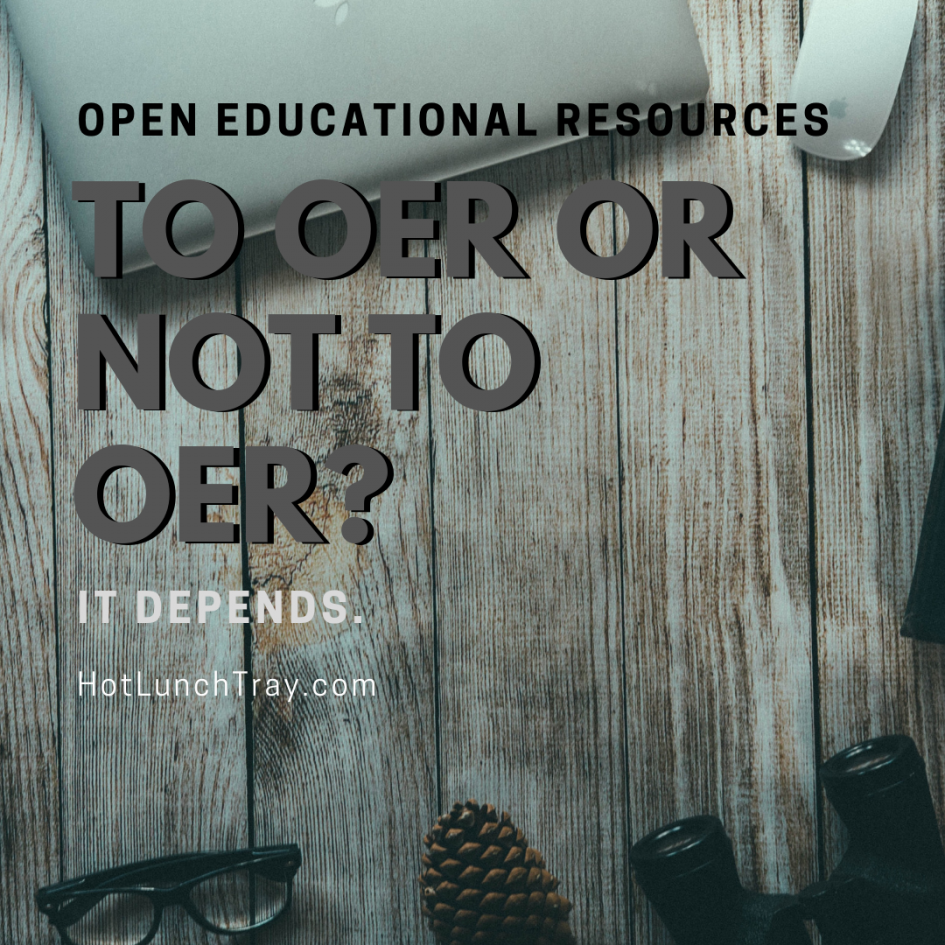If that is the question, the answer is it depends.
Open Educational Resources (OER) “Open Educational Resources are teaching, learning and research materials in any medium – digital or otherwise – that reside in the public domain or have been released under an open license that permits no-cost access, use, adaptation and redistribution by others with no or limited restrictions.” (DeBarger, 2016). The potential of OER excites educators who need a greater variety of resources. {OER one-pager}
Teachers currently invest time searching for resources online. As reported by McShane, “82% of elementary-school math teachers and 91% of high-school math teacher used materials that they created themselves or found on their own at least once a week (2017, p 21).” Then numbers are slightly higher for English language arts teachers, showing this is an issue across the subjects. Sites such as BetterLesson, Share My Lesson, and TeachersPayTeachers have growing memberships (McShane, 2017).
Teachers Need Less Work
Educators have an interest in finding appropriate content for students. Consider that only “16% of school districts are using openly licensed curricular materials” (South et al., 2018). There are many OERs available online. However, the Internet is intimidating in size and inefficient to search without a strategy and ample time. Educators need an approach to search for OER content.
Consider these Factors with OER
Alignment
There are a variety of ways to value alignment, alignment to standards, developmental appropriateness, and academic rigor. Alignment to either Common Core or state standards is very important. Typically concepts naturally align with standards and developmental ages, but content still needs to be vetted for this alignment. Academic rigor is an important alignment caveat to avoid a fun yet a non-educational collection of OER.
Quality
Standards of quality refer to the user experience. Quality is not about the often, and erroneous, presumed low-quality of OER resources (Krueger, 2018). Assembling a variety of resources can feel disjointed; to combat this potential disjointedness establish some non-negotiables for quality in OER. Suggestions include graphics, the absence of advertising, and no required logins or accounts. Students require quality content and the vetting educator(s) need to establish and adhere to quality standards.
Investment
Time – Several factors can contribute to the time invested in the use of OER materials. The initial investment of time comes in the form of locating or search for the OER content. This time often includes false-positives of finding items to only discover they do not have the correct copyright or have an associated cost.
An integration into a learning management or content management system is also a time-saving feature of OER providers. If presented with an OER integrated into an LMS/CMS it is a tremendous time-savings for the teacher and students. Often LMS integrations also incorporate grade-pass back which aids in grading efficiency as well.
The revision cycle of adapted OER is also a time cost. Alternatively, bookmarking the OER original site to check back for updates is also time-consuming. This time cost is also associated with teacher created materials.
Money – The investment of personnel is often a contentious topic. Often a contract position is proposed, or a teacher on temporary assignment, which does not create an additional permanent position; another position has associated human resources costs and in unattractive to schools or districts because of the increase in benefits. If the position is in addition to a full or part-time teaching contract this is stressful on the person in that position.
Occasionally a free resource generates integration costs. These could be to integrate into an LMS or CMS potentially; such integrations require some custom work which may require extra costs. Provisioning users via Classlink or another user portal may generate additional fees.
The free OER material may generate spin-off company which charges fees. Although it would not meet the definition of OER, the materials itself might become free in the future. Other times the resource closes, ends, or just disappears and the void may need to be filled by a paid vendor.
OER to Check Out
For student content consider:
OpenEd (now https://actacademy.act.org)
OpenEd does not itself create assessment content. We resell assessment content from most leading assessment publishers. So, of course, that content is available elsewhere. But on OpenEd, all of the assessment items are associated with specific instructional resources – optimally chosen to address the precise learning gap determined by the item.
OpenEd also assembles all of the items into prebuilt short classroom assessments. This is a task that districts usually perform themselves with extensive effort. The net result is that classroom assessment from OpenEd directly drive precisely chosen instructional resources for each student, based on their unique learning gaps. OpenEd is the only system that performs this task at scale (scale of resources and scale of teachers and topics).
OpenEd’s assessments are easily sharable with students via Google Classroom, Canvas, Schoology and dozens of others. They also run on a robust platform from ACT.
Khan Academy
Khan Academy offers practice exercises, instructional videos, and a personalized learning dashboard that empower learners to study at their own pace in and outside of the classroom.
No ads, no subscriptions. We are a not‑for‑profit because we believe in a free, world-class education for anyone, anywhere. We rely on our community of thousands of volunteers and donors. Learn more about getting involved today.
cK-12
An integrated set of tools for learning: digital textbooks, concept-based learning, SAT prep, and interactive Algebra curriculum (with additional math and science subjects in progress). All products can be customized to match the needs of the student, educator, or school.
Open Stax
We publish high-quality, peer-reviewed, openly licensed college textbooks that are absolutely free online and low cost in print. We’ve also developed low-cost, research-based courseware that gives students the tools they need to complete their course the first time around.
For your own professional learning OER experience, consider there platforms:
Coursera, edX, Canvas Network, and The MOOC List.






1 Pingback